Properties of Cobalt- and Nickel-Doped Zif-8 Framework Materials and Their Application in Heavy-Metal Removal from Wastewater
Abstract
1. Introduction
2. Experimental Section
2.1. Materials
2.2. Synthesis of Zeolite Imidazole Framework (ZIF-8), Co@ZIF-8 and Ni@ZIF-8
2.3. Metal Ion Adsorption Experiments
2.4. Characterization of Apparatus
2.5. Mathematical Equations and Methods
3. Results and Discussion
3.1. Characterization of Petal-Like ZIF-8 and Its Derivatives
3.1.1. The X-ray Diffraction (XRD) Pattern and Scanning Electron Microscope (SEM) Pictures of Petal-Like ZIF-8 and Its Derivatives
3.1.2. The Energy-Dispersive X-ray Spectroscopy (EDS) Mapping and X-ray Photoelectron Spectroscopy (XPS) of Petal-Like ZIF-8 and Its Derivatives
3.1.3. The Nitrogen Adsorption Experiment Analysis of Petal-Like ZIF-8 and Its Derivatives
3.2. Metal Adsorption Tests
3.2.1. Adsorption Results of Metal Ions
3.2.2. The Effect of pH on Adsorption Capacity
3.2.3. Kinetic Analysis of Adsorption Process
3.2.4. Diffusion Analysis in the Adsorption Process
3.2.5. The Shape of ZIF-8 and Its Derivatives after Adsorption
4. Conclusions
Author Contributions
Funding
Conflicts of Interest
References
- Kida, K.; Okita, M.; Fujita, K.; Tanaka, S.; Miyake, Y. Formation of High Crystalline ZIF-8 in an Aqueous Solution. CrystEngComm 2013, 15, 1794–1801. [Google Scholar] [CrossRef]
- Cravillon, J.; Münzer, S.; Lohmeier, S.; Feldhoff, A.; Huber, K.; Wiebcke, M. Rapid Room-Temperature Synthesis and Character-ization of Nanocrystals of a Prototypical Zeolitic ImidazolateFramework. Chem. Mater. 2009, 21, 1410–1412. [Google Scholar] [CrossRef]
- Pan, Y.C.; Liu, Y.Y.; Zeng, G.F.; Zhao, L.; Lai, Z.P. Rapid Synthesis of Zeolitic Imidazolate Framework-8 (ZIF-8) Nanocrystals in anAqueous System. Chem. Commun. 2011, 47, 2071–2073. [Google Scholar] [CrossRef] [PubMed]
- Huang, X.C.; Lin, Y.Y.; Zhang, J.P.; Chen, X.M. Ligand-Directed Strategy for Zeolite-Type Metal–Organic Frameworks: Zinc(II) Imidazolates with Unusual Zeolitic Topologies. Angew. Chem. Int. Ed. 2006, 45, 1557–1559. [Google Scholar] [CrossRef] [PubMed]
- Lu, G.; Li, S.; Guo, Z.; Farha, O.K.; Hauser, B.G.; Qi, X.Y.; Wang, Y.; Wang, X.; Han, S.Y.; Han, S.Y.; et al. Imparting functionality to a metal–organic framework material by controlled nanoparticle encapsulation. Nat. Chem. 2012, 4, 310–316. [Google Scholar] [CrossRef]
- Riccò, R.; Liang, W.B.; Li, S.B.; Gsaaensmith, J.J.; Garuso, F.; Doonan, C.; Falcaro, P. Metal−Organic Frameworks for Cell and Virus Biology: A Perspective. ACS Nano 2018, 12, 13–23. [Google Scholar] [CrossRef]
- Zhou, X.R.; Cheng, X.W.; Zhu, Y.H.; Elzatahry, A.A.; Alghamdi, A.; Deng, Y.H.; Zhao, D.Y. Ordered porous metal oxide semiconductors for gas sensing. Chin. Chem. Lett. 2018, 29, 405–416. [Google Scholar] [CrossRef]
- Pellitero, J.; Amrouche, H.; Siperstein, F.R.; Pirngruber, G.; Draghi, C.; Chaplais, G.; Masseron, A.; Bachi, D.; Peralta, D.; Bats, N. Adsorption of CO2, CH4, and N2 on Zeolitic Imidazolate Frameworks: Experiments and Simulations. Chem. Eur. J. 2010, 16, 1560–1571. [Google Scholar] [CrossRef]
- Gücüyener, C.; Den Bergh, J.V.; Gascon, J.; Kapteijn, F. Ethane/Ethene Separation Turned on Its Head: Selective Ethane Adsorption on the Metal-Organic Framework ZIF-7 through a Gate-Opening Mechanism. J. Am. Chem. Soc. 2010, 132, 17704–17706. [Google Scholar] [CrossRef]
- Den Bergh, J.V.; Gücüyener, C.; Pidko, E.A.; Hensen, E.J.M. Understanding the Anomalous Alkane Selectivity of ZIF-7 in the Separation of Light Alkane/Alkene Mixtures. Chem. Eur. J. 2011, 17, 8832–8840. [Google Scholar] [CrossRef]
- Zhang, X.X.; Xiao, P.; Zhan, G.H.; Liu, B.; Zhong, R.Q.; Yang, L.Y.; Sun, C.Y.; Liu, H.; Pan, Y.; Chen, G.J.; et al. Separation of Methane/Ethylene Gas Mixtures Using Wet ZIF-8. Ind. Eng. Chem. Res. 2015, 54, 7890–7898. [Google Scholar] [CrossRef]
- Tannka, S.; Fujita, K.; Miyake, Y.; Miyamto, M.; Hasegawa, Y.; Majino, T.; Der Perre, S.V.; Cousin, J.; Remi, S.; Van Assche, T.R.; et al. Adsorption and Diffusion Phenomena in Crystal Size Engineered ZIF-8 MOF. J. Phys. Chem. C 2015, 119, 28430–28439. [Google Scholar] [CrossRef]
- Gee, J.; Chung, J.; Nair, S.; Sholl, D.S. Adsorption and Diffusion of Small Alcohols in Zeolitic Imidazolate Frameworks ZIF-8 and ZIF-90. J. Phys. Chem. C 2013, 117, 3169–3176. [Google Scholar] [CrossRef]
- Zhang, D.; Fan, Y.; Li, G.J.; Du, W.; Li, R.L.; Liu, Y.M.; Cheng, Z.X.; Xu, J.Q. Biomimetic synthesis of zeolitic imidazolate frameworks and their application in high performance acetone gas sensors. Sens. Actuator B Chem. 2020, 302, 127187. [Google Scholar] [CrossRef]
- Xu, X.Y.; Ji, D.Q.; Zhang, Y.; Gao, X.H.; Xu, P.C.; Li, X.X.; Liu, C.C.; Wen, W.J. Detection of Phenylketonuria Markers Using a ZIF-67 Encapsulated PtPd Alloy Nanoparticle (PtPd@ZIF-67)-Based Disposable Electrochemical Microsensor. ACS Appl. Mater. Interfaces 2019, 11, 20734–20742. [Google Scholar] [CrossRef]
- Zhang, T.T.; Song, Y.; Xing, Y.; Gu, Y.; Yan, X.Y.; Liu, H.; Lu, N.N.; Xu, H.X.; Xu, Z.Q. The synergistic effect of Au-COF nanosheets and artificial peroxidase Au@ZIF-8(NiPd) rhombic dodecahedra for signal amplification for biomarker detection. Nanoscale 2019, 11, 20221–20227. [Google Scholar] [CrossRef]
- Jiang, H.L.; Liu, B.; Akita, T.; Haruta, M.; Sakurai, H.; Xu, Q. Au@ZIF-8: CO Oxidation over Gold Nanoparticles Deposited to Metal-Organic Framework. J. Am. Chem. Soc. 2009, 131, 11302–11303. [Google Scholar] [CrossRef]
- Tran, U.P.; Le, K.K.; Phan, N.T. Expanding Applications of Metal-Organic Frameworks: Zeolite Imidazolate Framework ZIF-8 as an Efficient Heterogeneous Catalyst for the Knoevenagel Reaction. ACS Catal. 2011, 1, 120–127. [Google Scholar] [CrossRef]
- Li, P.; Li, J.Z.; Feng, X.; Li, J.; Hao, Y.C.; Zhang, J.W.; Wang, H.; Yin, A.X.; Zhou, J.W.; Ma, X.J.; et al. Metal-organic frameworks with photocatalytic bactericidal activity for integrated air cleaning. Nat. Commun. 2019, 10, 2177. [Google Scholar] [CrossRef]
- Chen, W.H.; González, M.V.; Zoabi, A.; Reziq, R.A.; Willner, I. Biocatalytic cascades driven by enzymes encapsulated in metal–organic framework nanoparticles. Nat. Catal. 2018, 1, 689–695. [Google Scholar] [CrossRef]
- Bo, S.G.; Ren, W.J.; Lei, C.; Xie, Y.B.; Cai, Y.R.; Wang, S.L.; Gao, J.K.; Ni, Q.Q.; Yao, J.M. Flexible and Porous Cellulose Aerogels/Zeolitic Imidazolate Framework (ZIF-8) Hybrids for Adsorption Removal of Cr(IV) from Water. J. Solid State Chem. 2018, 262, 135–141. [Google Scholar] [CrossRef]
- Huang, Y.; Zeng, X.F.; Guo, L.L.; Lan, J.H.; Zhang, L.L.; Cao, D.P. Heavy metal ion removal of wastewater by zeolite-imidazolate frameworks. Sep. Purif. Technol. 2018, 194, 462–469. [Google Scholar] [CrossRef]
- Zhao, Y.J.; Pan, Y.C.; Liu, W.; Zhang, L.X. Removal of Heavy Metal Ions from Aqueous Solutions by Adsorption onto ZIF-8 Nanocrystals. Chem. Lett. 2015, 44, 758–760. [Google Scholar] [CrossRef]
- Li, N.; Zhou, L.; Jin, X.Y.; Owens, G.; Chen, Z.L. Simultaneous removal of tetracycline and oxytetracycline antibiotics from wastewater using a ZIF-8 Metal Organic-Framework. J. Hazard. Mater. 2019, 366, 563–572. [Google Scholar] [CrossRef] [PubMed]
- Jing, H.P.; Wang, C.C.; Zhang, Y.W.; Wang, P.; Li, R. Photocatalytic Degradation of Methylene Blue in ZIF-8. RSC Adv. 2014, 4, 54454–54462. [Google Scholar] [CrossRef]
- Kong, R.M.; Zhao, Y.; Zheng, Y.Q.; Qu, F.L. Facile synthesis of ZnO/CdS@ZIF-8 core–shell nanocomposites and their applications in photocatalytic degradation of organic dyes. RSC Adv. 2017, 7, 31365–31371. [Google Scholar] [CrossRef]
- Fang, G.; Li, W.F.; Shen, X.M.; Perez-Aguilar, J.M.; Chong, Y.; Gao, X.F.; Chai, Z.F.; Chen, C.Y.; Ge, C.C.; Zhou, R.H. Differential Pd-nanocrystal facets demonstrate distinct antibacterial activity against Gram-positive and Gram-negative bacteria. Nat. Commun. 2018, 9, 129. [Google Scholar] [CrossRef]
- Wang, X.B.; Liu, J.; Leong, S.; Lin, X.C.; Wei, J.; Kong, B.; Xu, Y.F.; Low, Z.X.; Yao, J.F.; Wang, H.T. Rapid Construction of ZnO@ZIF-8 Heterostructures with Size-Selective Photocatalysis Properties. ACS Appl. Mater. Interfaces 2016, 8, 9080–9087. [Google Scholar] [CrossRef]
- Zheng, G.C.; Chen, Z.W.; Sentosun, K.; Pérez-Juste, I.; Balas, S.; Liz-Marzan, L.M.; Pastoriza-Santos, I.; Pérez-Juste, J.; Mei, H. Shape control in ZIF-8 nanocrystals and metal nanoparticles@ZIF-8 heterostructures. Nanoscale 2017, 9, 16645–16651. [Google Scholar] [CrossRef]
- Liang, K.; Richardson, J.J.; Doonan, C.J.; Mulet, X.; Cui, J.W.; Caruso, F.; Facaro, P. An Enzyme-Coated Metal–Organic Framework Shell for Synthetically Adaptive Cell Survival. Angew. Chem. Int. Ed. 2017, 56, 8510–8515. [Google Scholar] [CrossRef]
- Wu, X.L.; Yang, C.; Ge, J.; Liu, Z. Polydopamine tethered enzyme/metal-organic framework composites with high stability and reusability. Nanoscale 2015, 7, 18883–18886. [Google Scholar] [CrossRef] [PubMed]
- Cai, C.L.; Zou, Y.J.; Xiang, C.L.; Chu, H.L.; Qiu, S.J.; Sui, Q.L.; Xu, F.; Sun, L.X.; Shan, A. Broccoli-like porous carbon nitride from ZIF-8 and melamine for high performance supercapacitors. Appl. Surf. Sci 2017, 440, 47–54. [Google Scholar] [CrossRef]
- Zhang, K.; Lively, P.R.; Zhang, C.; Koros, W.J.; Chance, R.R. Investigating the Intrinsic Ethanol/Water Separation Capability of ZIF-8: An Adsorption and Diffusion Study. J. Phys. Chem. C 2013, 117, 7214–7225. [Google Scholar] [CrossRef]
- Wang, X.J.; Zhang, H.G.; Lin, H.H.; Gupta, S.; Wang, C.; Tao, Z.X.; Fu, H.; Wang, T.; Zheng, J.; Wu, G.; et al. Directly Converting Fe-doped Metal-Organic Frameworks into Highly Active and Stable Fe-N-C Catalysts for Oxygen Reduction in Acid. Nano Energy 2016, 25, 110–119. [Google Scholar] [CrossRef]
- Butova, V.V.; Bulannova, E.A.; Polyakov, V.A.; Guda, A.A.; Aboraia, A.M.; Shapovaalov, V.V.; Zahran, H.Y.; Yahia, I.S.; Soldatov, A.V. The effect of cobalt content in Zn/Co-ZIF-8 on iodine capping properties. Inorg. Chim. Acta 2019, 492, 18–22. [Google Scholar] [CrossRef]
- Daniel, S.; Ammar, M.; Rammal, M.; Al-Ghoul, M.; Hmadeh, M. Crystal Growth of ZIF-8, ZIF-67, and Their Mixed-Metal Derivatives. J. Am. Chem. Soc. 2018, 140, 1812–1823. [Google Scholar]
- Bosts, J.A.; Calleja, G.; Sanchez, M.S.; Orcajo, M.G. Cobalt Doping of the MOF-5 Framework and Its Effect on Gas-Adsorption Properties. Langmuir 2010, 26, 5300–5303. [Google Scholar]
- Yang, J.M.; Liu, Q.; Sun, W.Y. Shape and size control and gas adsorption of Ni(II)-doped MOF-5 nano/microcrystals. Microporous Mesoporous Mater. 2014, 190, 26–31. [Google Scholar] [CrossRef]
- Cui, J.D.; Feng, Y.X.; Lin, T.; Tan, Z.L.; Zhong, C.; Jia, S.R. Mesoporous Metal−Organic Framework with Well-Defined Cruciate Flower-Like Morphology for Enzyme Immobilization. ACS Appl. Mater. Interfaces 2017, 9, 10587–10594. [Google Scholar] [CrossRef]
- Boparai, H.K.; Joseph, M.; O’Carroll, D.M. Kinetics and thermodynamics of cadmium ion removal by adsorption onto nano zerovalent iron particles. J. Hazard. Mater. 2011, 186, 458–465. [Google Scholar] [CrossRef]
- Yang, J.; Zheng, C.; Xiong, P.X.; Li, Y.F.; Wei, M.D. Zn-doped Ni-MOF material with a high supercapacitive performance. J. Mater. Chem. A 2014, 2, 19005–19010. [Google Scholar] [CrossRef]
- Bonnelle, J.P.; Grimiblot, J.; D’Huysser, A. Influence De La Polarisation Des Liaisons Sur Les Spectres Esca Des Oxydes De Cobalt. J. Electron. Spectrosc. Relat. Phenom. 1975, 7, 151–162. [Google Scholar] [CrossRef]
- Kishi, K. Adsorption of Ethylenediamine on Clean and Oxygen covered Fe/Ni(100) Surfaces studied by XPS. J. Electron Spectrosc. Relat. Phenom. 1988, 46, 237–247. [Google Scholar] [CrossRef]
- Chizallet, C.; Lazare, S.; Bachi, D.B.; Bonnier, F.; Lecocq, V.; Soyer, E.; Quolneaud, A.A.; Bats, N. Catalysis of Transesterification by a Nonfunctionalized Metal-Organic Framework: Acido-Basicity at the External Surface of ZIF-8 Probed by FTIR and ab Initio Calculations. J. Am. Chem. Soc. 2010, 132, 12365–12377. [Google Scholar] [CrossRef]
- Chen, H.; Wang, L.F.; Yang, J.; Yang, R.T. Investigation on Hydrogenation of Metal Organic Frameworks HKUST-1, MIL-53 and ZIF-8 by Hydrogen Spillover. J. Phys. Chem. C 2013, 117, 7565–7576. [Google Scholar] [CrossRef]
- Wang, H.; Yuan, X.Z.; Wu, Y.; Zeng, G.; Chen, X.H.; Leng, L.J.; Wu, Z.B.; Jiang, L.B.; Li, H. Facile synthesis of amino-functionalized titanium metal-organic frameworks and their superior visible-light photocatalytic activity for Cr(VI) reduction. J. Hazard. Mater. 2015, 286, 187–194. [Google Scholar] [CrossRef]
- Gupta, K.; Ghosh, U.C. Arsenic removal using hydrous nanostructure iron(III)–titanium(IV) binary mixed oxide from aqueous solution. J. Hazard. Mater. 2009, 161, 884–892. [Google Scholar] [CrossRef]
- Ren, Y.M.; Yan, N.; Feng, J.; Ma, J.; Wen, Q.; Li, N.; Dong, Q. Adsorption mechanism of copper and lead ions onto graphene nanosheet/ δ -MnO2. Mater. Chem. Phys. 2012, 136, 538–544. [Google Scholar] [CrossRef]
- Shahrak, M.N.; Ghahramaninezhad, M.; Eydifarash, M. Zeolitic imidazolate framework-8 for efficient adsorption and removal of Cr(VI) ions from aqueous solution. Environ. Sci. Pollut. Res. 2017, 24, 9624–9634. [Google Scholar] [CrossRef]
- Zhang, Y.J.; Xie, Z.Q.; Wang, Z.Q.; Feng, X.H.; Wang, Y.; Wu, A.G. Unveiling the adsorption mechanism of zeolitic imidazolate framework-8 with high efficiency for removal of copper ions from aqueous solutions. Dalton. Trans. 2016, 45, 12653–12660. [Google Scholar] [CrossRef]
- Navarro Poupard, M.F.; Polo, E.; Taboada, P.; Arenas-Vivo, A.; Horcajada, P.; Pelaz, B.; Del Pino, P. Aqueous Synthesis of Copper (II)-Imidazolate Nanoparticles. Inorg. Chem. 2018, 57, 12056–12065. [Google Scholar] [CrossRef] [PubMed]
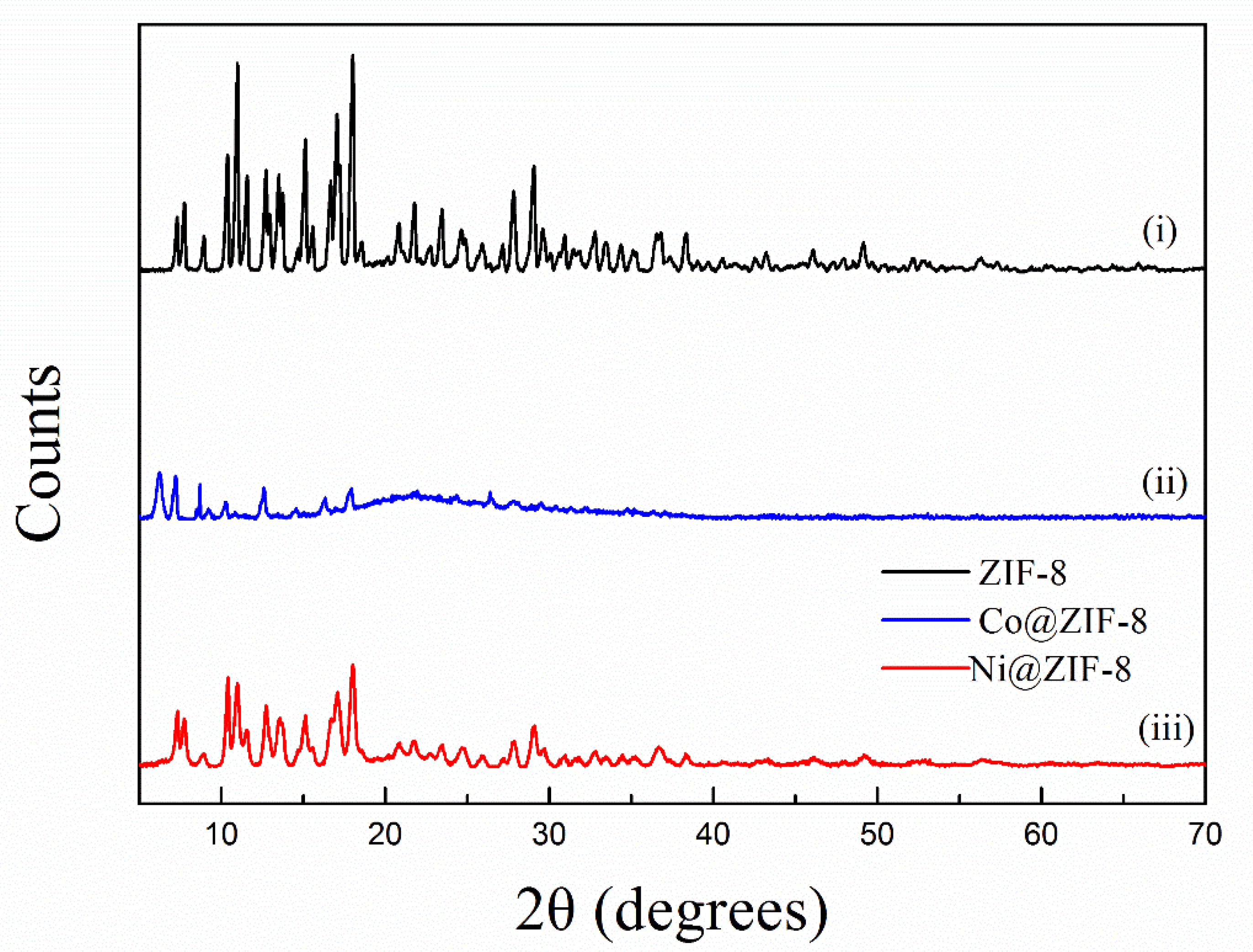
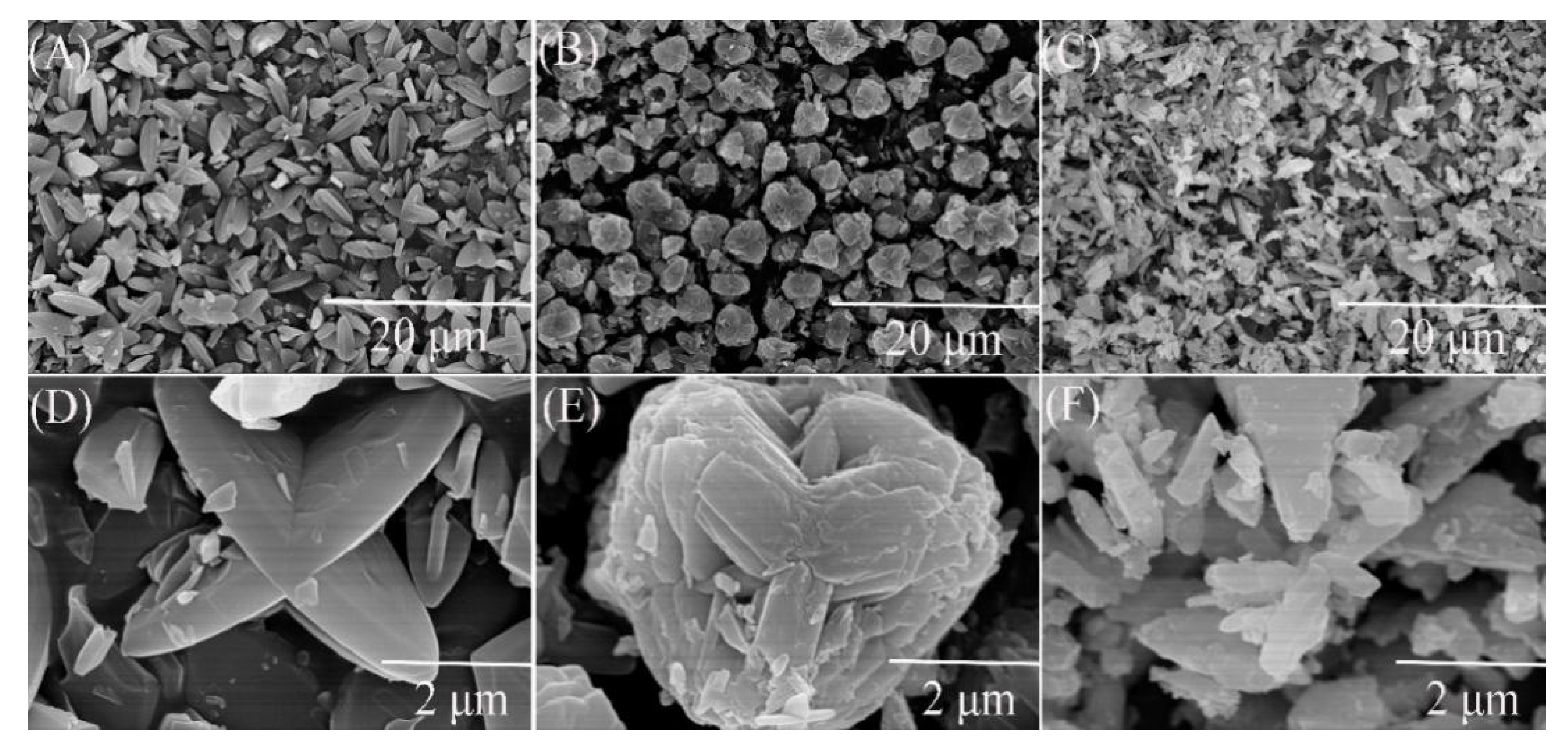
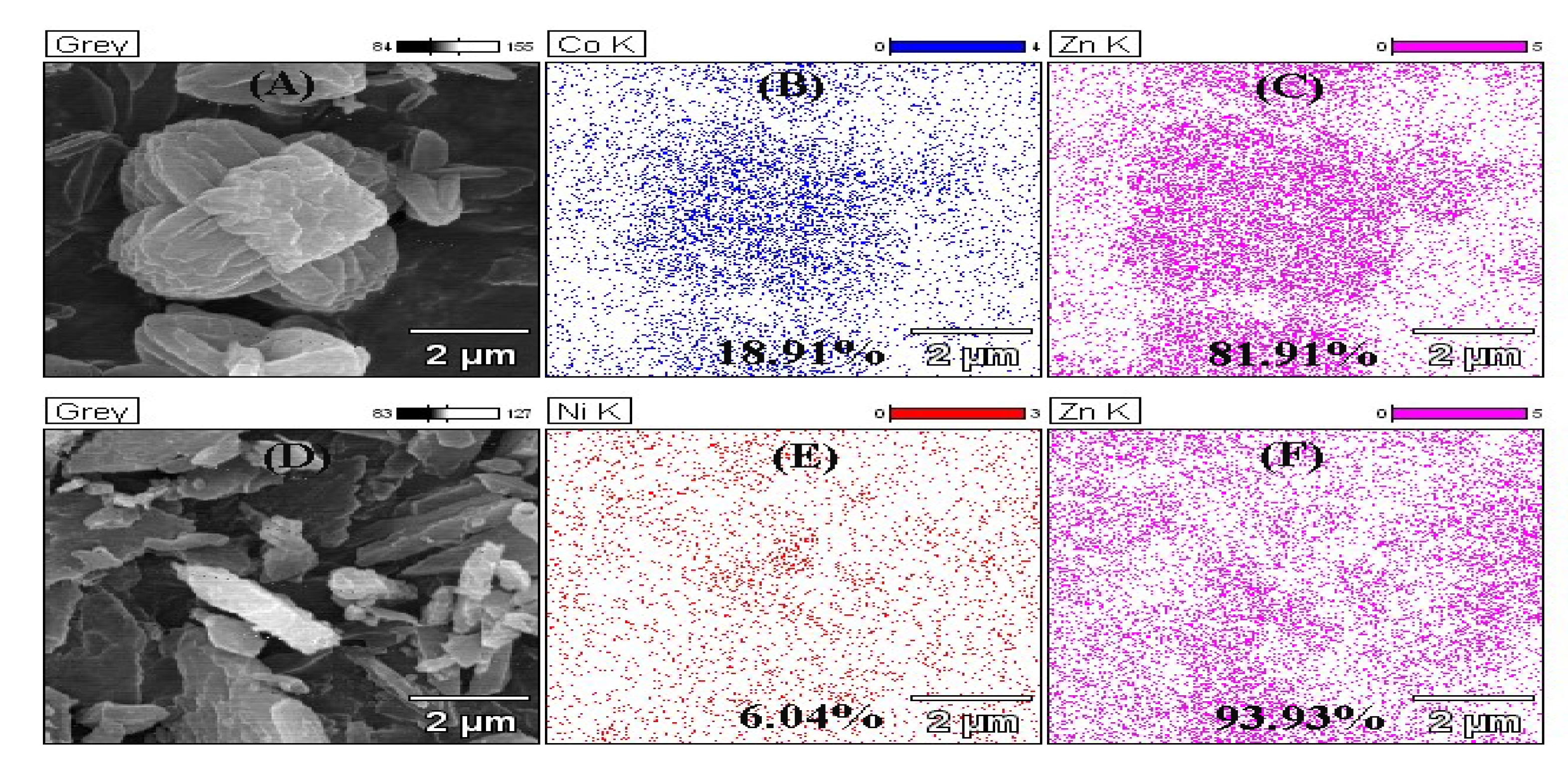
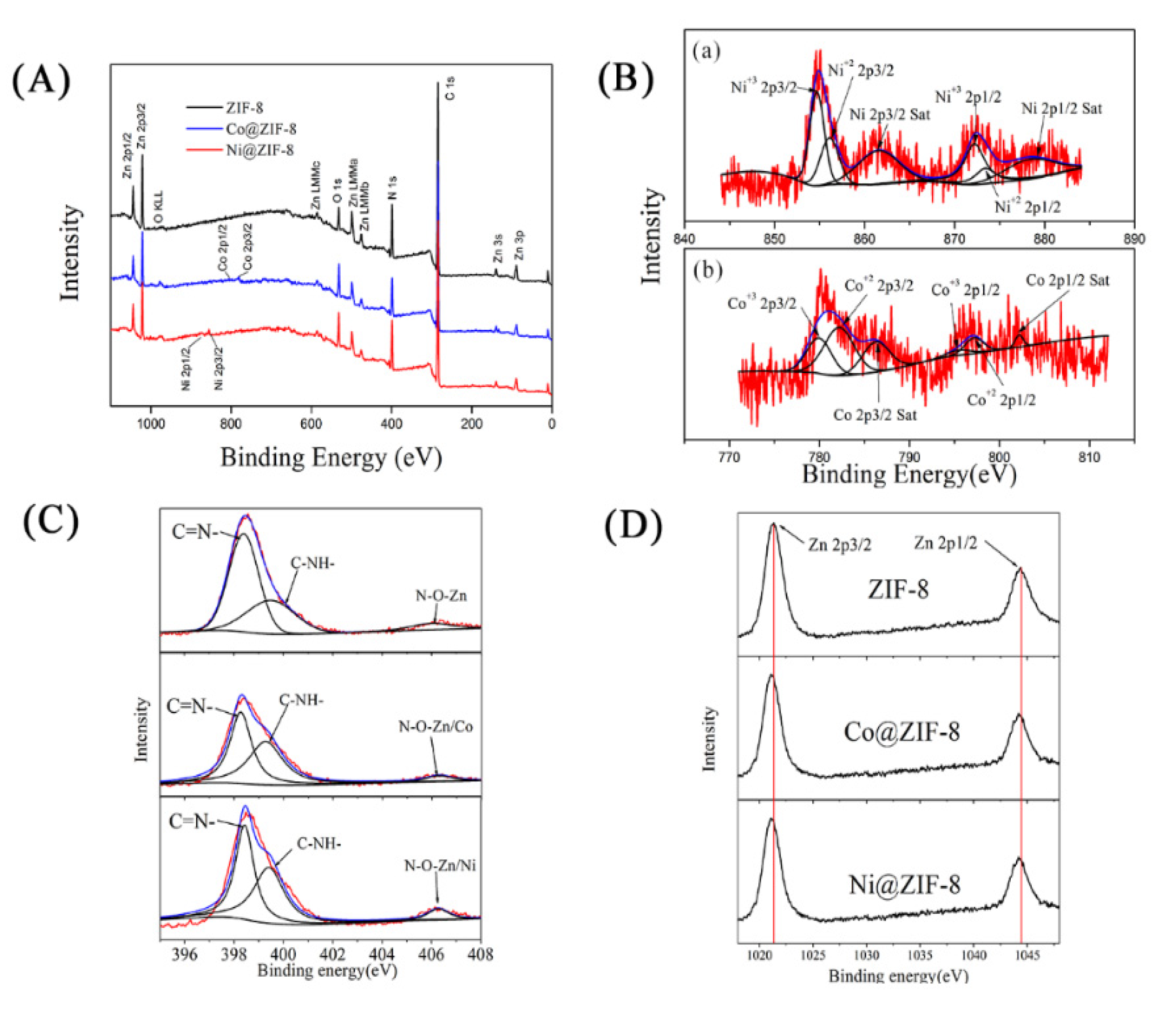

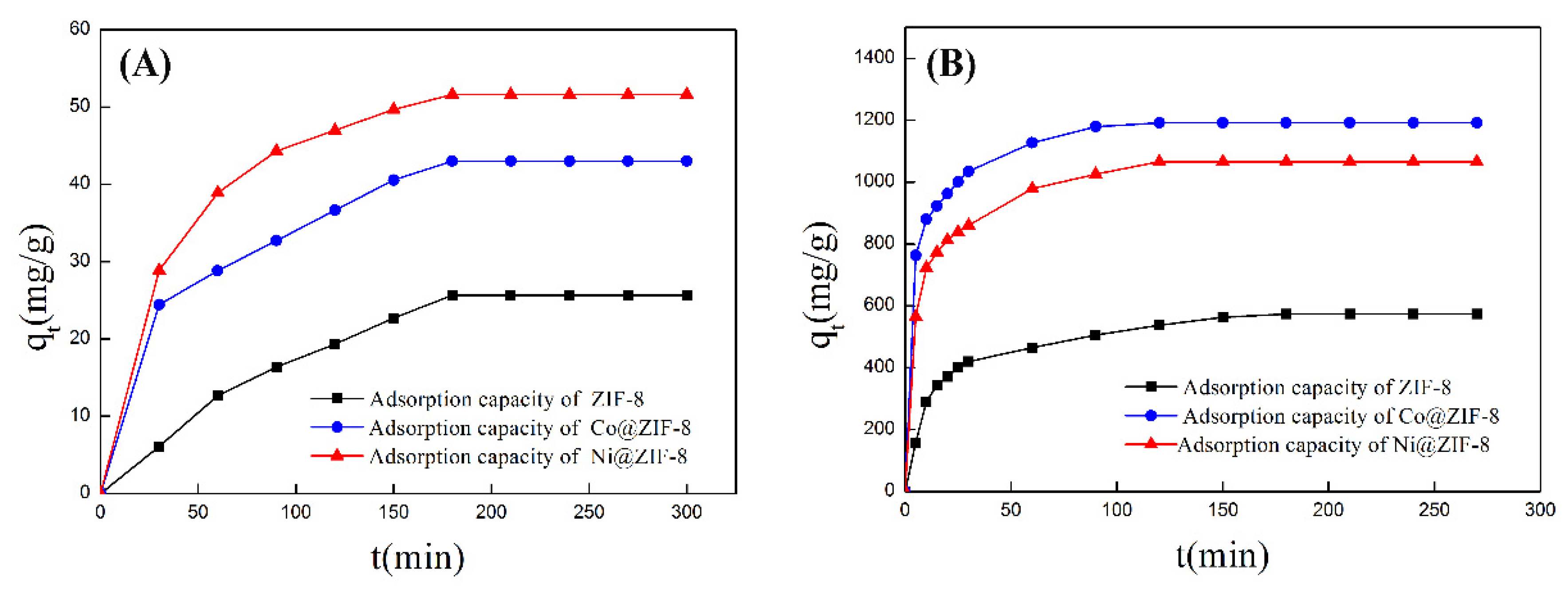
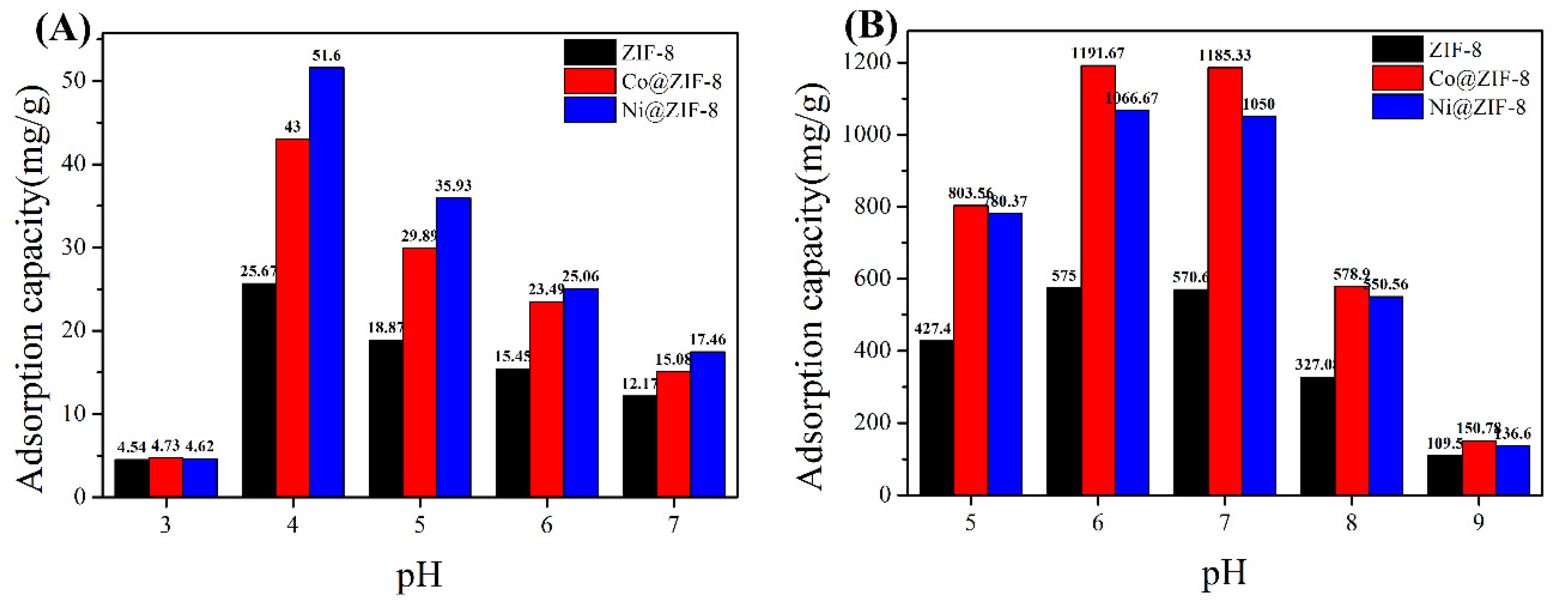
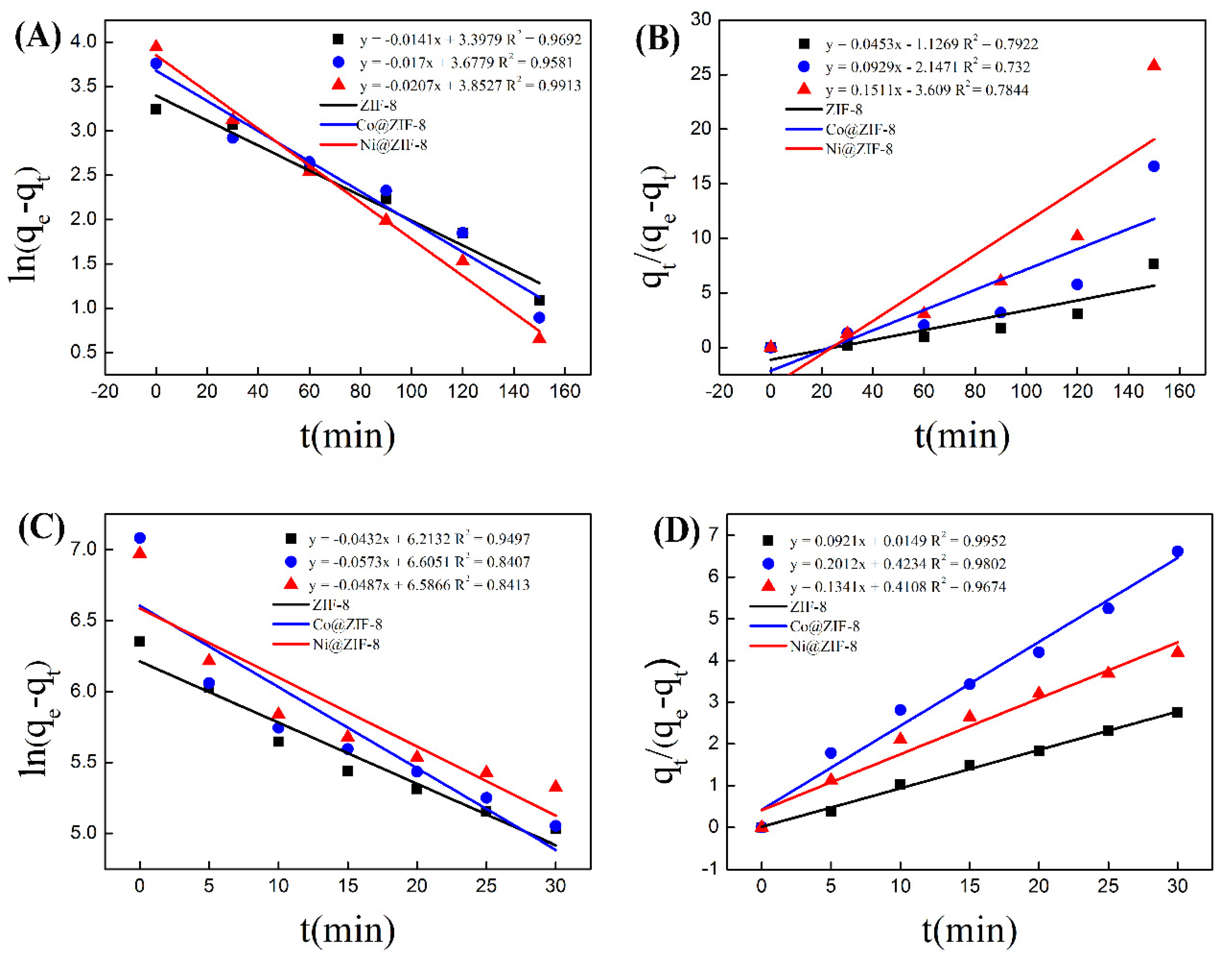
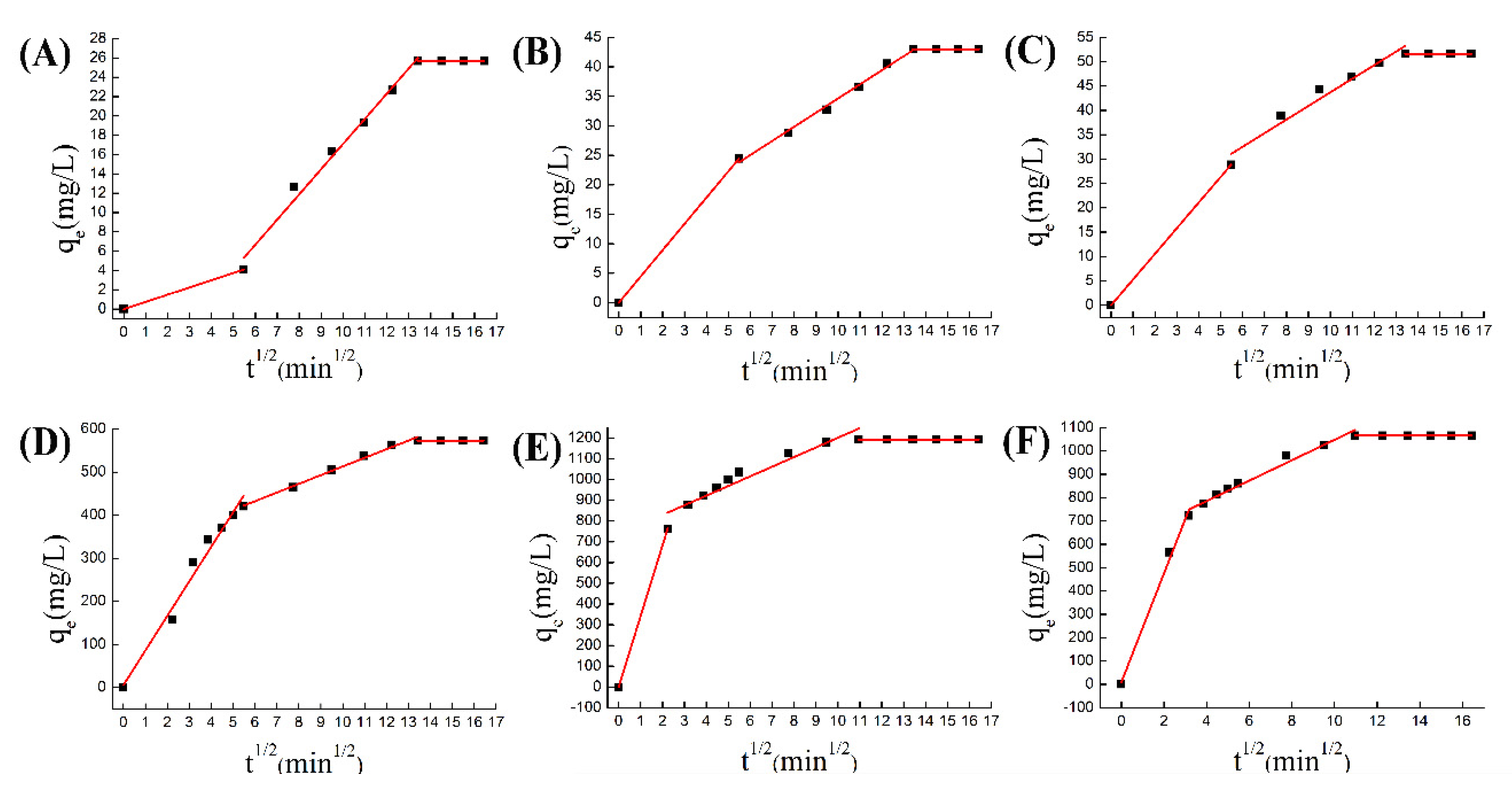
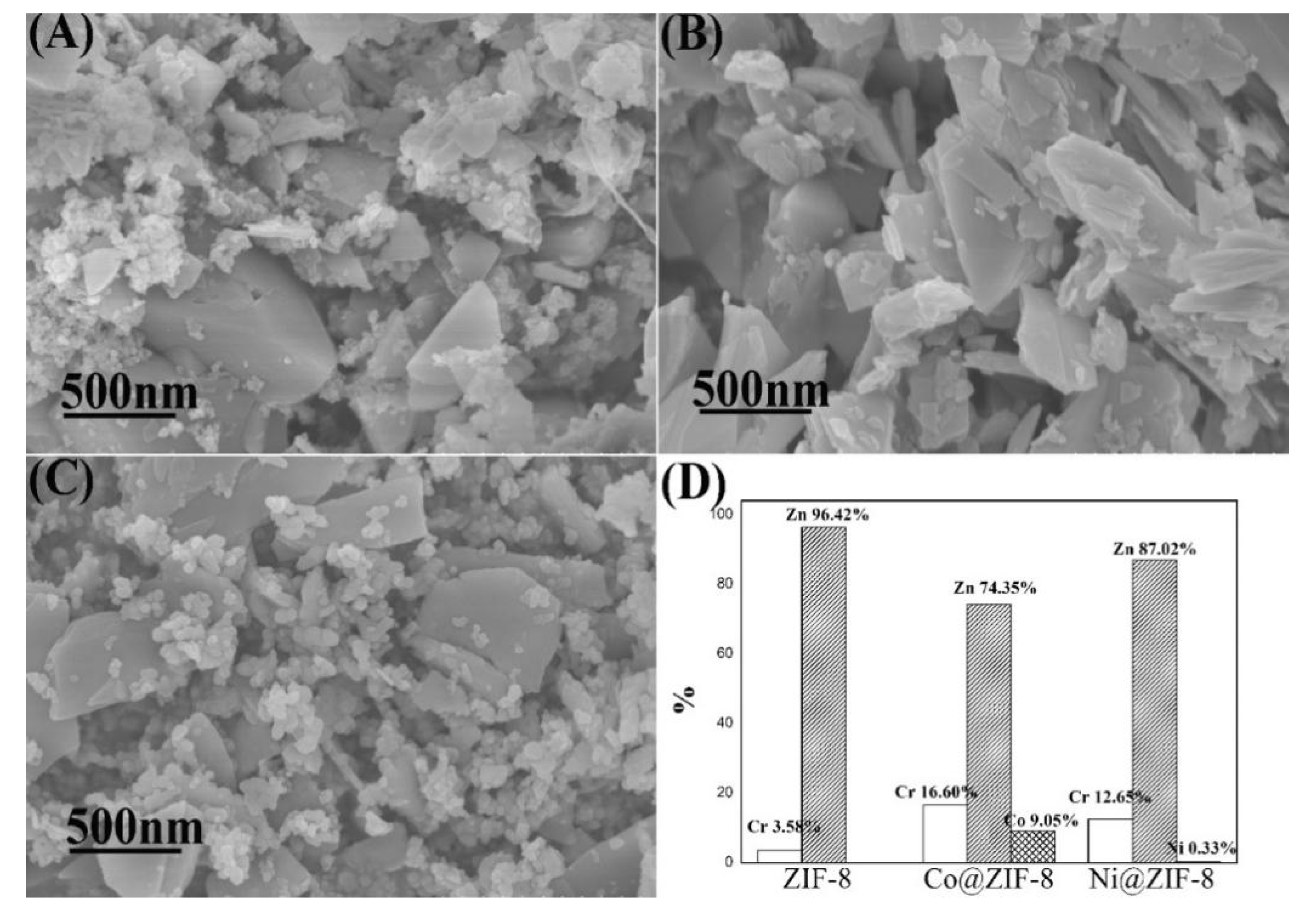
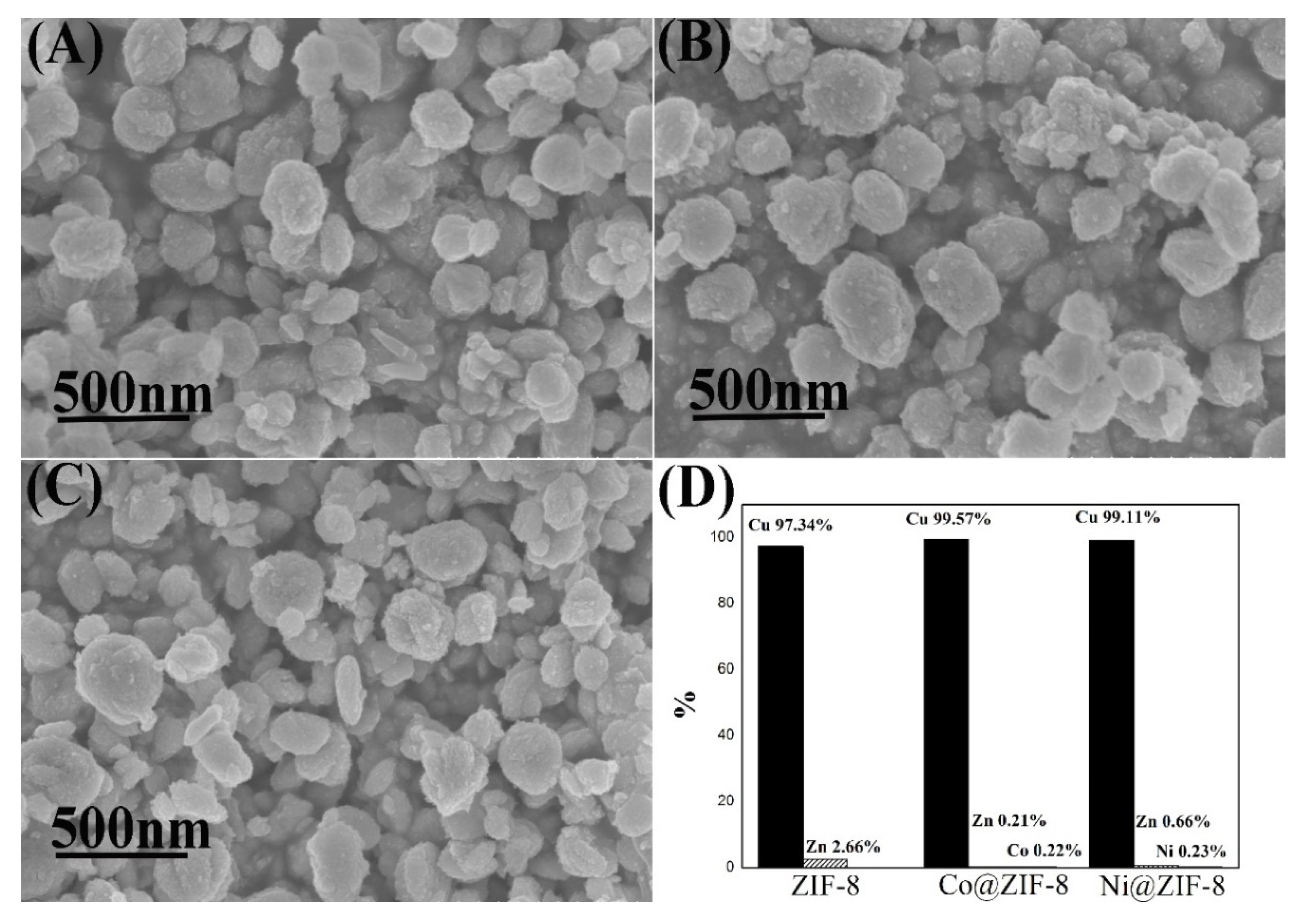
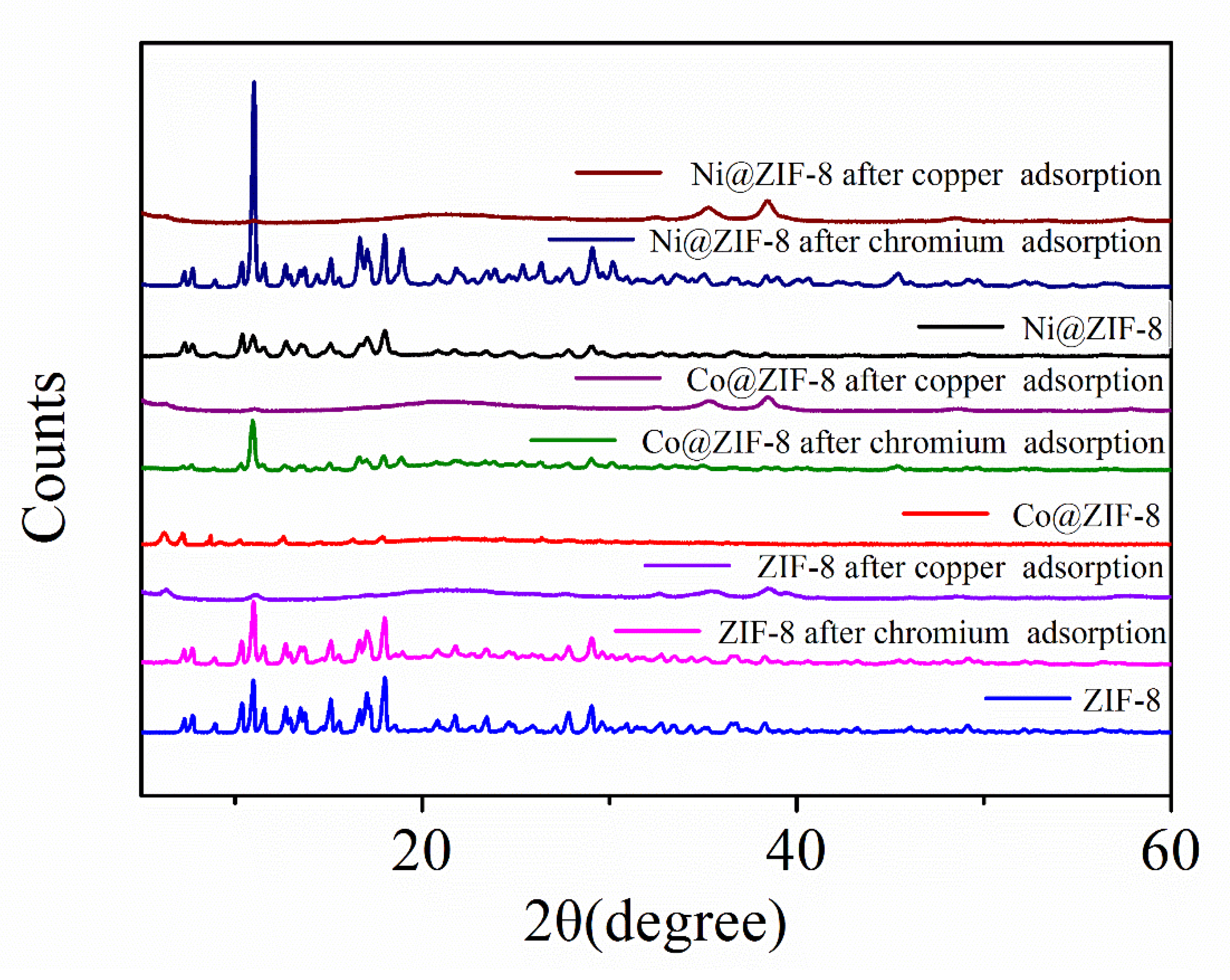
| Materials | Binding Energies of C=N–(eV) | Binding Energies of C–NH–(eV) | Binding Energies of Zn 2p3/2 (eV) | Binding Energies of Zn 2p1/2 (eV) |
|---|---|---|---|---|
| ZIF-8 | 398.7 | 399.7 | 1021.3 | 1044.8 |
| Co@ZIF-8 | 398.2 | 399.1 | 1020.7 | 1044.2 |
| Ni@ZIF-8 | 398.3 | 399.2 | 1020.7 | 1044.2 |
| Material | ZIF-8 | Co@ZIF-8 | Ni@ZIF-8 |
|---|---|---|---|
| BET Surface Area (m2/g STP) | 840.884 | 1072.73 | 259.93 |
| Average pore diameter (nm) | 8.111 | 4.7861 | 12.0861 |
| Material | Adsorption of Cr2O72− (mg/g) | Improvement Compared to ZIF-8 | Adsorption of Cu2+ (mg/g) | Improvement Compared to ZIF-8 |
|---|---|---|---|---|
| ZIF-8 | 25.67 | - | 575.00 | - |
| Co@ZIF-8 | 43.00 | 65.7% | 1191.67 | 107.25% |
| Ni@ZIF-8 | 51.60 | 101.01% | 1066.67 | 85.51% |
© 2020 by the authors. Licensee MDPI, Basel, Switzerland. This article is an open access article distributed under the terms and conditions of the Creative Commons Attribution (CC BY) license (http://creativecommons.org/licenses/by/4.0/).
Share and Cite
Shen, B.; Wang, B.; Zhu, L.; Jiang, L. Properties of Cobalt- and Nickel-Doped Zif-8 Framework Materials and Their Application in Heavy-Metal Removal from Wastewater. Nanomaterials 2020, 10, 1636. https://doi.org/10.3390/nano10091636
Shen B, Wang B, Zhu L, Jiang L. Properties of Cobalt- and Nickel-Doped Zif-8 Framework Materials and Their Application in Heavy-Metal Removal from Wastewater. Nanomaterials. 2020; 10(9):1636. https://doi.org/10.3390/nano10091636
Chicago/Turabian StyleShen, Bowen, Bixuan Wang, Liying Zhu, and Ling Jiang. 2020. "Properties of Cobalt- and Nickel-Doped Zif-8 Framework Materials and Their Application in Heavy-Metal Removal from Wastewater" Nanomaterials 10, no. 9: 1636. https://doi.org/10.3390/nano10091636
APA StyleShen, B., Wang, B., Zhu, L., & Jiang, L. (2020). Properties of Cobalt- and Nickel-Doped Zif-8 Framework Materials and Their Application in Heavy-Metal Removal from Wastewater. Nanomaterials, 10(9), 1636. https://doi.org/10.3390/nano10091636






